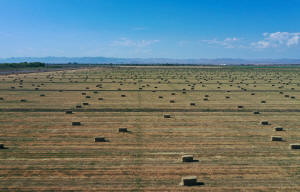U.S. crop insurance payouts rise sharply as climate change worsens
droughts, floods
 Send a link to a friend
Send a link to a friend
 [January 27, 2022]
By Leah Douglas [January 27, 2022]
By Leah Douglas
(Reuters) - Insurance payments to U.S.
farmers for crops lost to droughts and flooding have risen more than
threefold over the past 25 years, according to an analysis of federal
data by the Environmental Working Group (EWG) released on Thursday.
The report reinforces concerns that insuring the nation’s crops will get
more expensive for insurance companies, farmers and taxpayers as climate
change drives more erratic weather events that disrupt agriculture.
The federal government pays about 60% of the nation’s crop insurance
premiums through taxpayer subsidies, according to the Congressional
Budget Office, and those premiums tend to rise as insurance payouts
grow.
Insurance payments to farmers due to drought rose more than 400% between
1995 and 2020 to $1.65 billion, while payments due to excess moisture –
like floods - rose nearly 300% to $2.61 billion, according to the
nonprofit environmental group, which examined publicly available data
from the U.S. Department of Agriculture.
Reuters reviewed the data, which showed a steady upward trend in
insurance payouts over the period.
During the period analyzed by EWG, the number of insured acres grew just
84.5%, according to the data from the department’s Risk Management
Agency, which administers the federal crop insurance program.

[to top of second column]
|

An aerial view shows agricultural fields as California faces its
worst drought since 1977, in Mundo, California, U.S., July 4, 2021.
Picture taken with a drone REUTERS/Aude Guerrucci
 “As extreme weather has become more
frequent, the climate crisis has already increased insurance
payments and premium subsidies. These costs are expected to go up
even more, as climate change causes even more unpredictable weather
conditions," EWG said in the report.
The report did not detail average increases in premiums since 1995.
The cost of insuring crops, however, could increase between 3.5% and
22% by 2080 due to climate change, even if farmers adapted what and
where they plant, according to a 2019 USDA report.
The most commonly insured crops include corn, soybeans, wheat and
cotton.
The federal crop insurance program requires farmers to meet minimal
conservation standards, like not planting on land highly vulnerable
to erosion.
But Anne Weir Schechinger, the Midwest director of EWG, said those
standards should be tougher. “The program needs to be reformed so it
encourages farmers to be resilient to extreme weather events that we
know are ahead,” she said.
(Reporting by Leah Douglas in Washington; Editing by Matthew Lewis)
[© 2022 Thomson Reuters. All rights
reserved.]
This material may not be published,
broadcast, rewritten or redistributed.
Thompson Reuters is solely responsible for this content. |